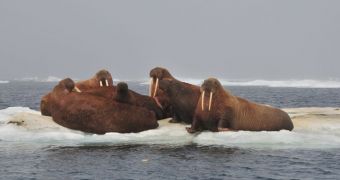Seals, polar bears and walruses are all species that are heavily dependent on ice for their very survival. As ice sheets are getting smaller due to the effects of global warming, experts are beginning to study how these species handle the change. American experts are just embarking on such an endeavor.
The work is being conducted by scientists with the United States Geological Survey (USGS) Alaska Science Center, who are working in collaboration with the Native Village of Point Lay. The goal of this investigation is to attach 35 satellite radio-tags to just as many walruses.
All the targeted animals need to be selected from an area on the northwestern coasts of Alaska, given that the goal of the study is to determine how Pacific walruses are handling current ice loss rates.
Over the past few years, the most severely-reduced sea ice conditions have been recorded in late summer and during fall. “Sea ice is an important component in the life cycle of walruses,” scientist Chad Jay explains.
“These tracking studies will help us to better understand how top consumers in the arctic ecosystem may be affected by changes in sea ice habitats,” adds the expert, who holds an appointment as a research ecologist at the USGS ASC.
Last month, USGS experts attached about 40 radio tags to walruses living northwest of Barrow, Alaska, at the very edge of the continental shelf. This distant offshore sea ice is at a very high risk of melting ahead of more solid ice sheets, closer to the continental shelf.
“Walruses spend most of their lives at sea, but haul out on sea ice and sometimes land to rest between feeding bouts. They can dive hundreds of feet to forage on the sea floor,” an USGS press release says.
“However, when the sea ice recedes past the continental shelf into very deep waters of the Arctic Basin, the walruses haul out on land. The extent of sea ice has been less in recent summers, and walruses have been hauling out on beaches in Alaska and Russia in the past few years,” the statement adds.
Under these circumstances, analyzing the patterns in which the animals move from water to land and vice-versa can provide indications as to how the creatures are responding to ice changes both close and far away to the continent.
In 2011, remote ice sheets have already melted nearly in their entirety, as evidenced by the fact that a large number of walruses have already been spotted ashore. Normally, they would be in the open sea during this time of the year.

 14 DAY TRIAL //
14 DAY TRIAL //